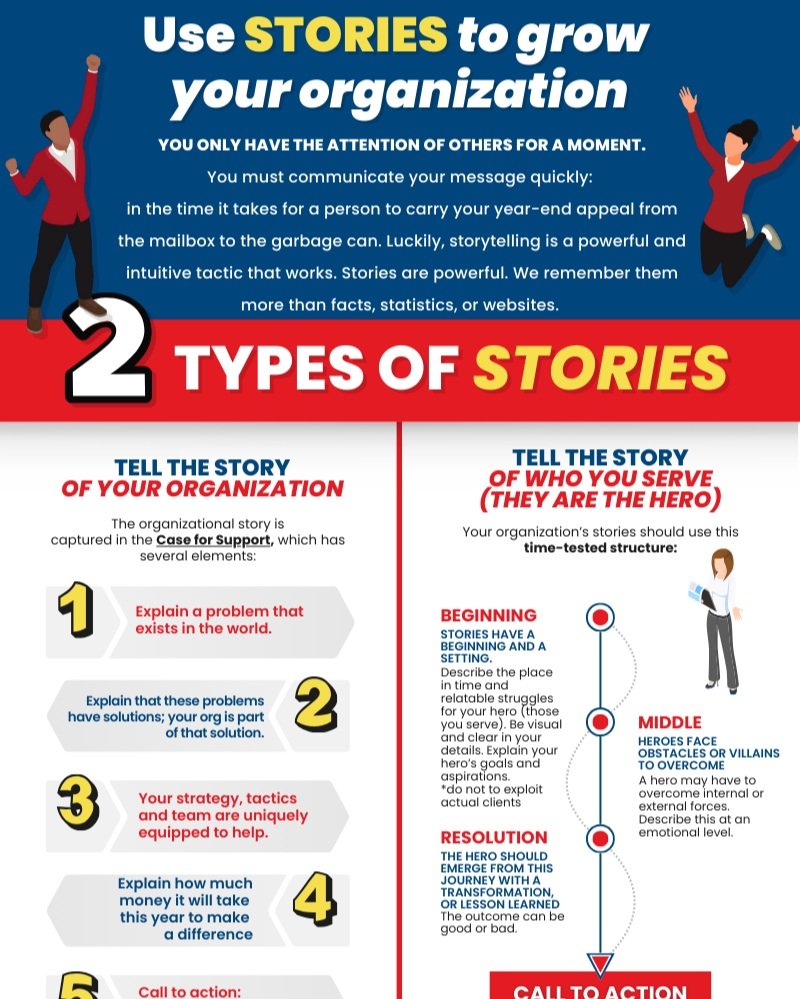Infographic: Nonprofit Storytelling for Pros
Making the world a better place is hard work. Getting other people to care as much as we do is critical to enlisting volunteers and donors so we can achieve our mission.
We only have the attention of others for a moment. How do we get our message out in the time it takes individuals to “swipe right” or between the mailbox and the garbage can? We must learn how to break through. Luckily, there is evidence of a tactic that works: storytelling. Stories are powerful. We remember them more than facts, statistics, or websites. Nonprofits should be better storytellers.
Storytelling follows a few different frameworks. I have adapted them all for nonprofits in a free infographic to keep it simple.
Nonprofits must be able to tell two stories: The organizational story and the story of those you serve. Even if you help the planet or civil rights, you must bring it back to the individuals in order for storytelling to have the greatest impact.
Tell your organizational story: The organizational story is captured in the Case for Support. A case for support has several elements:
1) Explain that there are problems in the world. (Show the problem, don't just tell)
2) This problem can be solved.
3) Our organization is uniquely situated to address the problem. (Our strategy, tactics, and team can make a difference.)
4) In order to have this impact, it will take a specific amount of time and human resources.
5) Call to Action – Will you join us on this journey by pitching in?
Tell the story of those you help: Stories have an arc. There is a beginning, a middle, and an end.
1) Beginning: There are characters and a setting. You want to have a protagonist (hero) who is relatable. Develop them. Paint a picture. (Show, don’t tell.) The hero has goals and aspirations.
2) In the middle, there will be an antagonist (a person or force) that causes conflict for the hero. Forces are at odds with the protagonist or there are pain points our hero must overcome. Why does this conflict matter at an emotional or value-based level?
3) The hero should emerge at the end of this journey and there should be a resolution, transformation, or lesson learned (it doesn’t always need to have a good outcome).
4) There needs to be a call to action. Link the story to your mission and needs. Ask your audience to help the hero and others like them.
Get the free infographic here.
Here are four principles to keep in mind when constructing a good story.
Principle 1) Stories make our brains pay attention. We can repeat them and feel connected. Getting involved feeds an inner need to resolve conflict and do good.
Principle 2) Telling the story of trees or owls or abstract laws may grab my interest, but not as much as a person who needs those things. Remember, show, don’t tell.
Principle 3) There is evidence that we are more likely to respond to the needs of one, rather than of many. Mother Theresa said, “If I look at the mass I will never act. If I look at the one I will.” It’s called social loafing: we are lazy in groups. We can’t tell the story of 5 million who are suffering, but we can tell the story of one.
Principle 4) In the book Made to Stick, the authors say that the most powerful messages are simple, unexpected, concrete, credible, emotional, and story-based.
Get the free infographic here.


